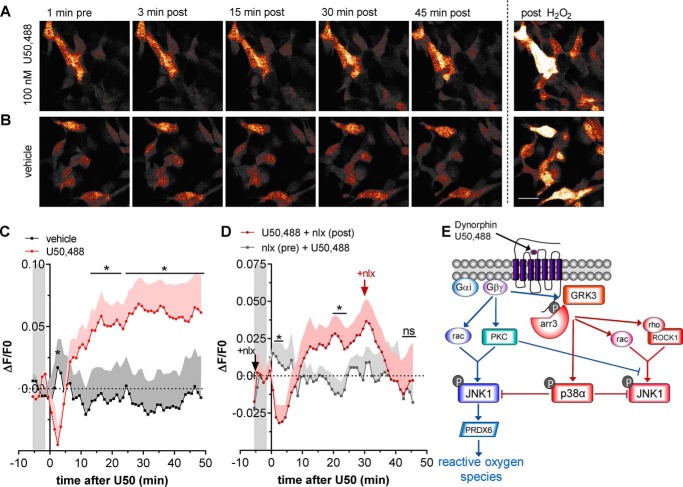Figure 6.
U50,488 stimulates ROS in live cells and is reversed by naloxone. A and B, HEK293 cells stably expressing mycKOR were transiently transfected with HyPerRed 24 h prior to imaging for HyPerRed fluorescence every 60 s. Cells were treated with 100 nm U50,488 (A) or vehicle (B), and fluorescence was quantified. At the end of the experiment, cells were treated with 200 μm H2O2 to confirm responsiveness. The scale bar represents 25 μm for images in both A and B. C, quantification of data in A and B. Fluorescence was significantly increased by U50,488 in mycKOR-expressing HEK293 cells (repeated-measures two-way ANOVA (significant effect of time, F54,432 = 2.531, p < 0.0001 and significant interaction between time and drug, F54,432 = 3.948, p < 0.0001; effect of drug, F1,8 = 2.907, p = 0.1324; n = 9) with Holm–Šidák post hoc comparison against vehicle (*, p < 0.05)). The graph depicts mean ± S.E. D, cells were pretreated with 10 μm naloxone (nlx) or vehicle 5 min prior to treatment with 100 nm U50,488; cells were post-treated with vehicle or 10 μm naloxone 30 min after U50,488 (U50). 45 min after U50,488 treatment, cells were treated with 200 μm H2O2. Fluorescence was significantly increased after U50,488 treatment in mycKOR-expressing HEK293 cells that were not pretreated with naloxone (repeated-measures two-way ANOVA (significant interaction between time and drug, F51,306 = 3.475, p < 0.0001; effect of time, F51,306 = 0.9146, p = 0.6409; effect of drug, F1,6 = 0.8464, p = 0.3931; n = 7) with Holm–Šidák post hoc comparison against naloxone pretreatment (*, p < 0.05; ns, not significant)). E, schematic of JNK signaling by KOR agonists. KOR activation promotes analgesia and cognitive disruptions through G protein–mediated mechanisms, including regulation of various ion channels, adenylyl cyclase, and ERK1/2 MAPK. G protein–dependent GRK3 phosphorylation of KOR at Ser-369 promotes arrestin (arr) recruitment, resulting in arrestin-scaffolded p38 MAPK activation and aversion in addition to receptor desensitization. This study describes another aspect of signaling in which βγ subunits also promote JNK activation through G protein–mediated activation of RAC1 and PKC, resulting in increased oxidative signaling via PRDX6 PLA2 activity. This pathway is directly inhibited by G protein–mediated, arrestin-scaffolded activation of p38 MAPK.

